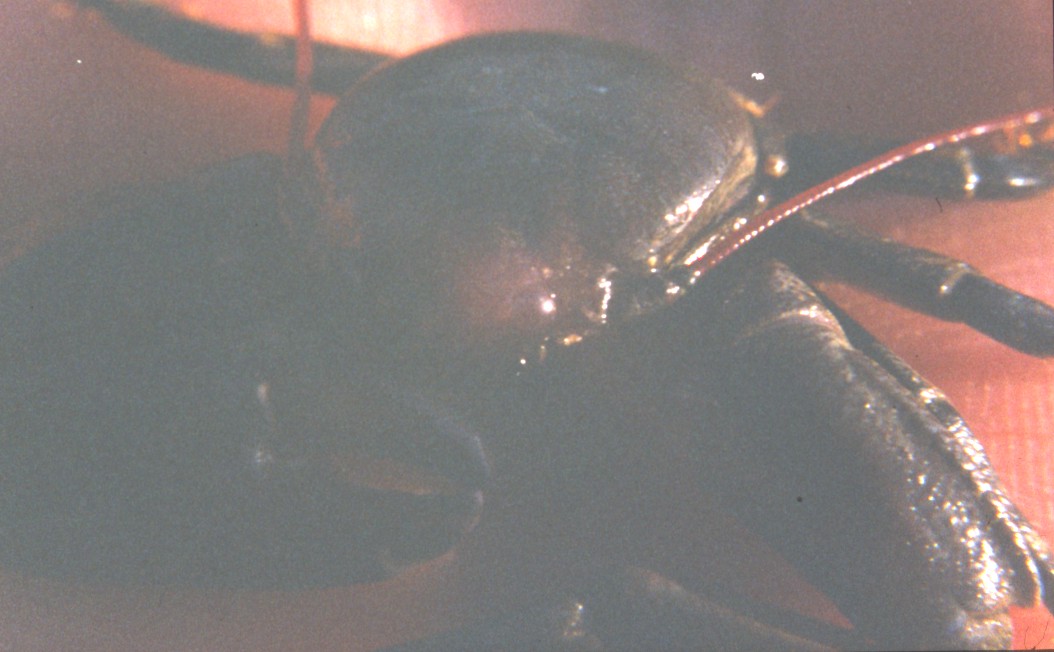Petrolisthes cinctipes (Randall, 1839)Common name(s): Flat porcelain crab, Smooth porcelain crab |
|
| Synonyms: Petrolisthes rupicolus, Porcellana cinctipes, Porcellana rupicola |  |
| Phylum Arthropoda
Subphylum Crustacea Class Malacostraca Subclass Eumalacostraca Superorder Eucarida Order Decapoda Suborder Pleocyemata Infraorder Anomura Superfamily Galatheoidea Family Porcellanidae |
|
| Petrolisthes cinctipes from San Simeon, CA. Carapace width approx. 1.5 cm | |
| (Photo by: Dave Cowles, May 2001) | |
How to Distinguish from Similar Species:Petrolisthes eriomerus has a cheliped with a longer carpus with parallel margins, its antennal flagellae are greenish, and it has blue on its mouthparts and on the cheliped.
Geographical Range: Queen Charlotte Islands, Canada to Point Conception, CA + northern Channel Islands in CA. Most common in southern part of range.
Depth Range: Upper and middle intertidal
Habitat: Under stones and in mussel beds., especially on the outer coast.
Biology/Natural History: A very common inhabitant of mussel beds in central and northern California. Feeds on plankton and suspended detritus by using the feathery hairs on its maxillipeds, which it waves in the water. Occasionally eats algae or dead animal tissue. Reproduces all year in California, March to July in Puget Sound. Eggs are bright red or maroon when laid, fade to brownish red. As with all porcelain crabs, this species will readily drop (autotomize) its claws if grasped by them (probably the source of the name--they break easily like fine china). Unlike P. eriomerus, the claw of this crab stops pinching when dropped. The zoea larvae of porcelain crabs have extremely long spines, especially the rostral spine. This species can often be found in the same areas as P. eriomerus, but this species avoids hiding under rocks that have sand or sediments around them so they are usually higher in the intertidal. They don't generally swim, but if forced to do so they often swim with their ventral side up, flapping their abdomen with their uropods extended for propulsion.
Individuals are often found with puncture wounds on their claws (Rypien et al., 2007). This seems to be due to interspecific competition in the form of "shoving matches". The incidence of injuries is similar for males and females, suggesting the competition may be for space rather than for mates. Injuries are most common on intermediate (not the largest) individuals and in more crowded, wave-exposed sites.
| Return to: | |||
| Main Page | Alphabetic Index | Systematic Index | Glossary |
References:
Dichotomous Keys:Flora and Fairbanks, 1966
Hart, 1982
Kozloff 1987, 1996
Smith and Carlton, 1975
Wicksten, 2009
General References:
Jensen,
1995
Johnson
and Snook, 1955
Kozloff,
1993
McConnaughey
and McConnaughey, 1985
Morris
et al., 1980
O'Clair
and O'Clair, 1998
Ricketts
et al., 1985
Sept,
1999
Scientific Articles:
Delmanowski, Robert M., Cory L. Brooks, Hailey Salas, and Brian Tsukimura, 2017. Reproductive life history of Petrolisthes cinctipes (Randall, 1840) and P. manimaculis Glassell, 1945 (Decapoda: Anomura: Porcellanidae), with the development of an enzyme-linked immunosorbant assay (ELISA) for the determination of hemolymph levels of vitellogenin. Journal of Crustacean Biology 37:3 pp 315-322doi:10.1093.jcbiol/rux017
Stillman, Jonathon H., John K. Colbourne, Carol E. Lee, Nipam H. Patel, Michelle R. Phillips, David W. Towle, Brian D. Eads, Greg W. Gelembuik, Raymond P. Henry, Eric A. Johnson, Michael E. Pfrender, and Nora B. Terwilliger, 2008. Advances in crustacean genomics. Integrative and Comparative Biology 48:6 pp 852-868
Stillman, Jonathon H., Kristen S. Teranishi, Abderrhamane Tagmount, Erika A. Lindquist, and Peter B. Brokstein, 2006. Construction and characterization of EST libraries from the procelain crab, Petrolisthes cinctipes. Integrative and comparative biology 46:6 919-930 : Characterizing genes which are transcribed in this species under different temperature conditions.
Rypien, Krystal L. and A. Richard Palmer, 2007. The
effects of
sex, size and habitat on the incidence of puncture wounds in the claws
of the porcelain crab Petrolisthes cinctipes
(ANOMURA: PORCELLANIDAE).
J. Crustacean Biology 27:1 59-64
Web sites:
General Notes and Observations: Locations, abundances, unusual behaviors:

View of the mouthparts. Note that there is no blue border on
the mouth parts--instead they have a reddish border.

Front view. Note that the antennal flagellae are red.
Authors and Editors of Page:
Dave Cowles (2006): Created original page